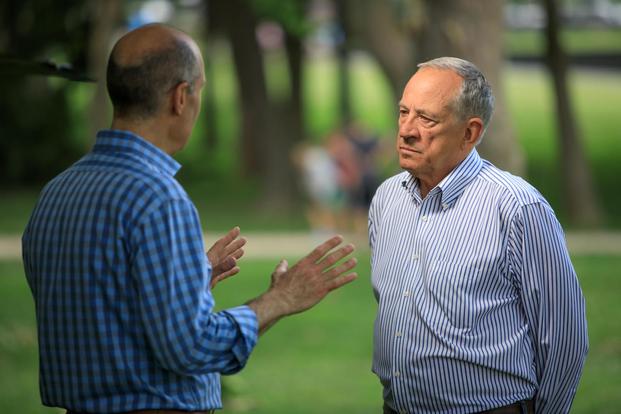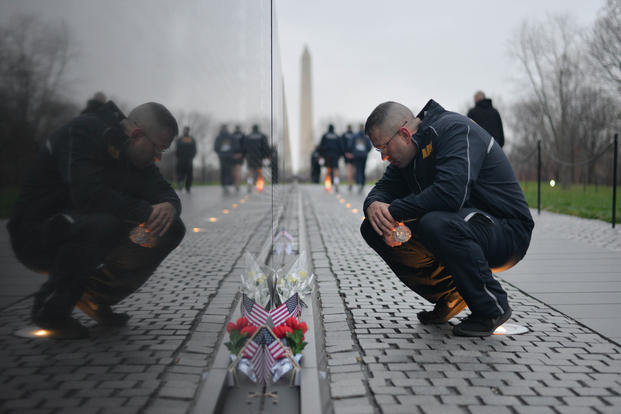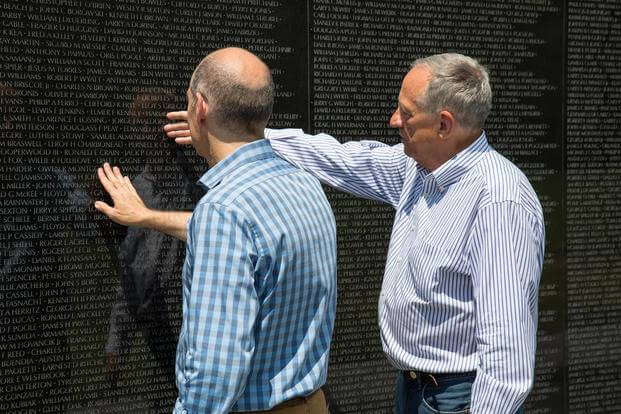Army veteran Jan Scruggs, credited as the driving force behind the Vietnam Veterans Memorial, is profiled in the PBS documentary "10 Monuments That Changed America," part of the "10 That Changed America" series airing Tuesdays at 8pm ET on most PBS stations.
In the "10 Monuments That Changed America" episode (premiering July 17th), host Geoffrey Baer visits sites that include the Statue of Liberty, Mount Rushmore and Vietnam Veterans Memorial. He also profiles the AIDS Quilt, a monument that's not tied to a single location. Monuments can often be contentious, and the show doesn't shy away from the battles over some designs and the current controversies about Confederate monuments in the South.
We had an opportunity to speak with Jan Scruggs about the documentary and his work in the Vietnam Veterans Memorial.
You’ve developed a reputation as a go-to person on military monuments.
Well, I’m a little footnote of history there, but I do have a great interest in monuments and memorials. I'm involved with The Global War on Terror Memorial. And, of course, the Vietnam Veterans Memorial. I was involved with the Law Enforcement Officers Memorial and others here in Washington D.C. And it’s almost a growth industry now, actually, if you look at it.
Recently, the Desert Storm veterans got a site sort of near the Vietnam Veterans Memorial, to place a monument to honor their sacrifices. And they’re working on the monument for the Global War on Terror. A World War I Memorial is getting close to fruition in Washington D.C. That’s a hundred years late, but still it will be built.
So I do follow all this and I'm an active participant from time to time.
You describe yourself as a footnote. I don’t think that’s being fair to yourself. The Vietnam Veterans Memorial has gone a long way to helping people process and deal with the fallout from the Vietnam War.
The Vietnam Veterans Memorial has really evolved into somewhat of a national shrine and it even has sort of religious qualities.
There was a theologian named Gustav Niebuhr who used to work for the New York Times. He wrote an article that compared it to an altar for America, where the veterans come, we leave items there, and other people are moved by it.
It’s a place of great equality. None of the names on the Vietnam Veterans Memorial have the rank. A corporal versus the colonel are right next to each other, but no one outranks one another. So it’s a good place, a good place of remembrance.
We encourage everyone to see it. Also this new documentary "10 Monuments That Changed America" is very poignant and important and I hope a lot of people see it.

Can you tell us about your service and how you got involved with the Vietnam Veterans Memorial?
I went to Bowie High School in Maryland. After high school, I volunteered to go into the army for two years. And they made me an infantryman. At the time, there were many openings in that occupational specialty.
We were taking pretty heavy causalities. I joined in 1968 and I got wounded and saw some terrible things. War is a pretty ugly phenomenon. But I got back and I think I had some PTSD. I think a lot of people did, but I became an expert on Post-Traumatic Stress Disorder. I wrote an article, two articles in the Washington Post, and I testified in front of Congress and wrote an article in Military Medicine calling for something to be done nationally, which helped bring about what's called the Vet Center Program.
After seeing the movie “The Deer Hunter,” I decided that I was gonna build the National Vietnam Veterans Memorial in Washington D.C. I just thought I'd be able to figure out how to do it, but my naivete was amazing.
However, I got the ball rolling and ultimately got some really talented people involved, particularly a bunch of graduates from the Harvard Business School who were also from the class of 1966 at West Point. They took the really smart ones and sent them to Harvard before going to Vietnam. We put together the Vietnam Veterans Memorial and basically treated it like a Harvard Business School problem and came up with some deadlines.
We started in 1979 and, by 1982, the Memorial was built and dedicated. It was a great success and it’ll never happen again. They changed all the rules in Washington after we sidestepped a lot of processes for site selection.

The design was radically different than any monument that had come before. How did that come about?
We had an architecture of design competition, the largest one in the history of western civilization at the time. We wanted a monument that blended in well with the surroundings. one was reflective and contemplative, those were the two words, and the monument had to have all of the names on it.
We weren't trying to do anything old-fashioned or new-fashioned or avant-garde, but we ended up with this great design by a young lady named Maya Lin. And it’s proved to be a great success.
You live close to Washington. How often do you visit the Mall and spend time at the monument now?
I live in Annapolis, Maryland. I'm retired. I don’t get to Washington D.C. very much, but I've been to the Vietnam Veterans Memorial probably 1200 times. I've been there a lot.
What kind of progress do you think we’re making on the War on Terror and World War I monuments, specifically? When might we see those dedicated?
Here's one thing that's kind of interesting. We started with the Vietnam Veterans Memorial and about six years later there was the national Korean War Veterans Memorial, then later there was a World War II Memorial. So they tend to go in reverse. We would think they should have built the World War II Memorial first, then Korea, then Vietnam. But I'm the one who took the initiative and changed things.
Now they're trying to raise some money to complete the World War I Memorial. As you might imagine, there isn’t anyone who remembers World War I or served in it. There are none. I met the last surviving World War I veteran about seven years ago.
But the Desert Storm and the Global War on Terror memorials are both moving forward. I think you'll see both of them done in a period of between, I would say, six to ten years. They should both be completed in Washington D.C. It’s good.
The whole trick with the Vietnam Veterans Memorial was to separate the war from the warrior. We did that very successfully. We have to remember that these monuments are not there to praise war, particularly some of the most recent wars we’ve had. They're kind of controversial. These monuments honor the service of the veterans and they’re the people who gave their lives and risked their lives to fight these wars.
Not to say that anyone who fought in Iraq and Afghanistan during the last decade and a half doesn’t deserve a Memorial as much as anyone else, but it’s a little disconcerting that we’re plotting a memorial for a war that’s not over yet.
Right. And it will not be over in your lifetime or mine. We’re applauding war, we’re applauding the service of the military veterans who were willing to fight it.
“10 Monuments That Changed America” doesn’t look or sound like the most of the documentaries we’re used to seeing on PBS.
These guys out of Chicago who made the film are really bright and thoughtful. They came up with a really brilliant idea of sharing these stories. Society needs places that we can share as things we agree are good, like Gettysburg, like Concord Bridge. The monuments that they show here are part of our country, the Arizona Memorial in Pearl Harbor. It’s good to give us some time to think about what brings us together instead of what tears us apart.





